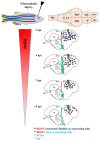BDNF, Brain, and Regeneration: Insights from Zebrafish
- PMID: 30322169
- PMCID: PMC6214035
- DOI: 10.3390/ijms19103155
BDNF, Brain, and Regeneration: Insights from Zebrafish
Abstract
Zebrafish (Danio rerio) is a teleost fish widely accepted as a model organism for neuroscientific studies. The adults show common basic vertebrate brain structures, together with similar key neuroanatomical and neurochemical pathways of relevance to human diseases. However, the brain of adult zebrafish possesses, differently from mammals, intense neurogenic activity, which can be correlated with high regenerative properties. Brain derived neurotrophic factor (BDNF), a member of the neurotrophin family, has multiple roles in the brain, due also to the existence of several biologically active isoforms, that interact with different types of receptors. BDNF is well conserved in the vertebrate evolution, with the primary amino acid sequences of zebrafish and human BDNF being 91% identical. Here, we review the available literature regarding BDNF in the vertebrate brain and the potential involvement of BDNF in telencephalic regeneration after injury, with particular emphasis to the zebrafish. Finally, we highlight the potential of the zebrafish brain as a valuable model to add new insights on future BDNF studies.
Keywords: Fish; Trk B; neuroregeneration; neurotrophins; p75.
Conflict of interest statement
The authors declare no conflict of interest.
Figures


References
-
- Wullimann M.F., Rupp B., Reichert H. Neuroanatomy of the Zebrafish Brain: A Topological Atlas. Birkhauser; Berlin, Germany: 1996.
Publication types
MeSH terms
Substances
LinkOut - more resources
Full Text Sources
Research Materials

